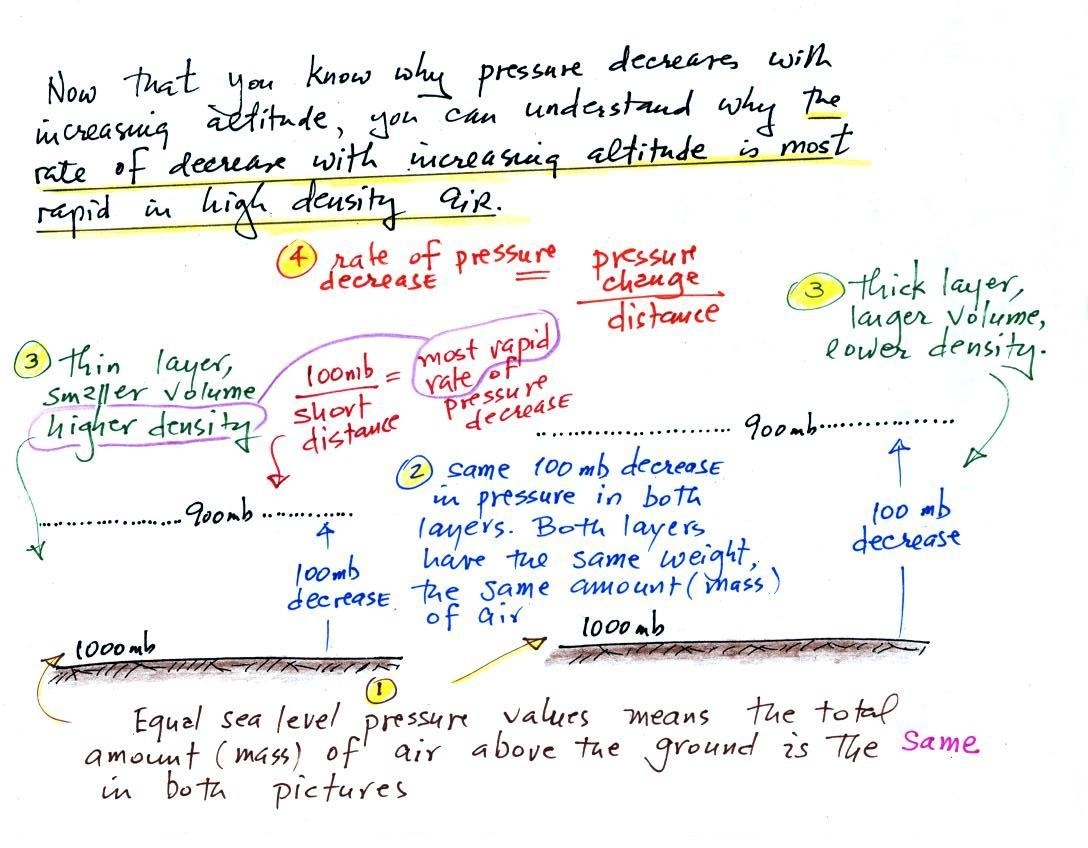
There's a lot going on in this picture, we'll examine it step by step.
1. The sea level pressure is 1000 mb, a typical value for sea level pressure. It's the same in both pictures. Since pressure is determined by the weight of the air overhead, the weight of the air overhead in the left picture is the same as in the right picture. The amount (mass) of air above sea level in both pictures is the same.
2. As you travel upward from sea level to the level of the dotted line in both pictures there is a 100 mb drop in pressure. Pressure has decreased because air that was overhead (the air between the ground the level of the dotted line) is now underneath. Because the pressure change is the same in both pictures the weight of the air layers are the same. The thin layer at left has the same weight as the thicker layer at right. If their weights are equal, both layers must contain the same amount (mass) of air.
3. Both layers contain the same amount (mass) of air. The air in the layer at left is thinner. The air is squeezed into a smaller volume. The air in the layer at left is denser than the air in the layer at right.
4. To determine the rate of pressure decrease you divide the pressure change (100 mb for each layers) by the distance over which that change occurs. The 100 mb change takes place in a shorter distance in the layer at left than in the layer at right. The left layer has the highest rate of pressure decrease with increasing altitude.
So both the most rapid rate of pressure decrease with altitude and the densest air are found in Layer A. That's what we wanted to demonstrate.
Next week we'll add an additional detail. We'll find that high density air is often cold air. Low density air is often warm air.
The fact that the rate of pressure decrease with increasing altitude depends on air density is a fairly subtle but important concept. This concept will come up 2 or 3 more times later in the semester. For example, we will need this concept to explain why hurricanes can intensify and get as strong as they do.
2.
The second topic was more enjoyable in my opinion. That's probably because it mostly consisted of pictures.
The second topic was more enjoyable in my opinion. That's probably because it mostly consisted of pictures.
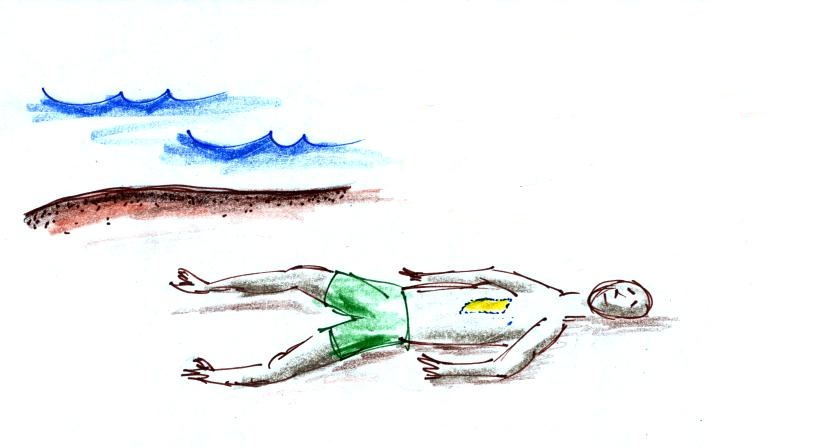
Sea level pressure, 14.7 psi, might not
sound like much. But when you start to multiply 14.7 by
all the square inches on your body it turns into a lot of
pounds (force). The yellow box on the person's chest in
the picture is a brick size, 4" x 8" = 32 square inch
area. If you multiply 14.7 psi by 32 sq. in. you get 470
pounds! It would take a stack 90 - 100 bricks tall to
produce that much weight.
Why isn't the person in the picture above crushed by the weight of the atmosphere above. The answer is that the person's body pushes back with the same amount of force. Air does the same thing. This is the topic we will explore next.
Why isn't the person in the picture above crushed by the weight of the atmosphere above. The answer is that the person's body pushes back with the same amount of force. Air does the same thing. This is the topic we will explore next.
The figure above and statements such as
"pressure at any level in the atmosphere depends on (is
determined by) the weight of the air overhead" might leave
you with the idea that pressure just pushes downward.
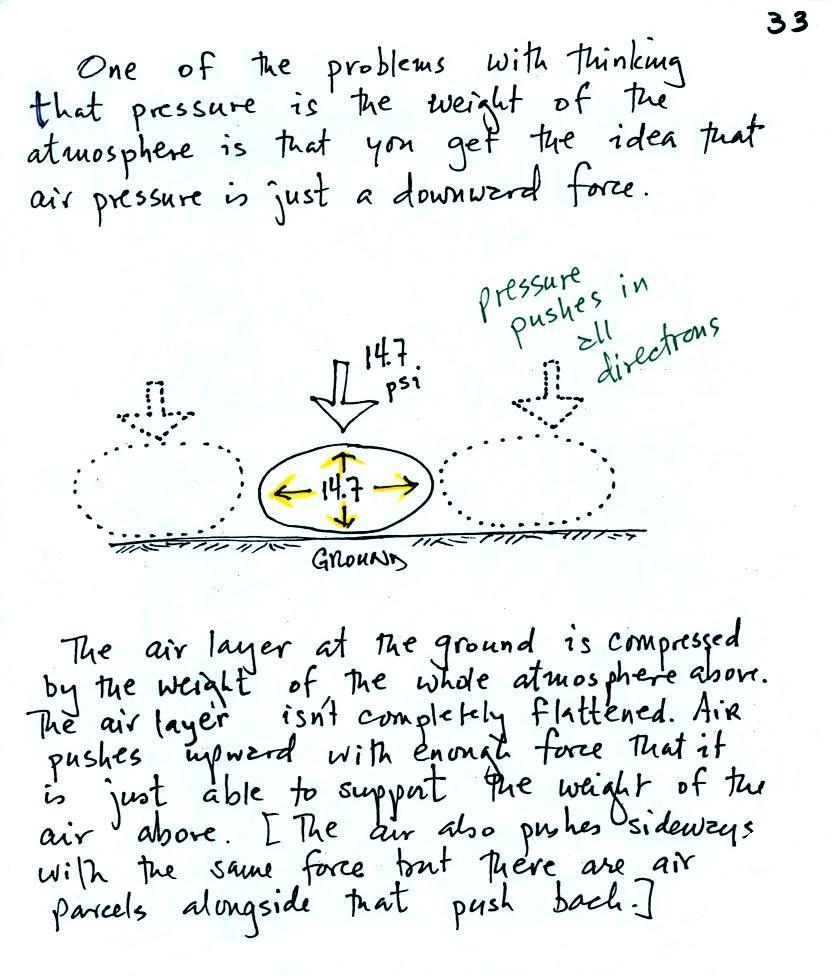
Air pressure is a force
that pushes downward, upward, and sideways. If you fill
a balloon with air and then push downward on it, you can feel
the air in the balloon pushing back (pushing upward).
You'd see the air in the balloon pushing sideways as
well.

We were able to see this by placing a brick
on top of a balloon. The balloon gets squished (pushed
out sideways) but not flattened. It eventually pushes
upward with enough force to support the brick. If I
could figure out a way of keeping the balloon from moving too
far sideways and popping I could have gotten on the table and
stood on the balloon. With only a little compression it
would have been able to support all 150 pounds of my weight.
Another helpful representation of air in the atmosphere might be a people pyramid.
Another helpful representation of air in the atmosphere might be a people pyramid.
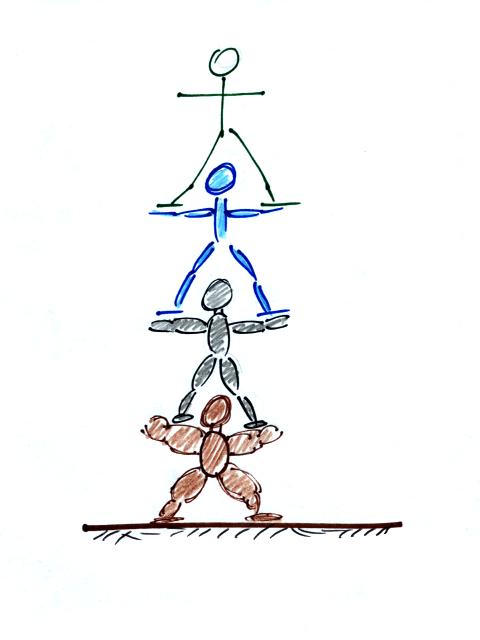
The people in the figure are analogous to
layers of air in the atmosphere all stacked on top of each
other.
If the bottom person in the stack above were standing on a scale, the scale would measure the total weight of all the people in the pile. That's analogous to sea level pressure being determined by the weight of the all the air above.
The bottom person in the picture above must be strong enough to support the weight of all the people above. The bottom layer of the atmosphere pushes upward with enough pressure to support the weight of the air above.
If the bottom person in the stack above were standing on a scale, the scale would measure the total weight of all the people in the pile. That's analogous to sea level pressure being determined by the weight of the all the air above.
The bottom person in the picture above must be strong enough to support the weight of all the people above. The bottom layer of the atmosphere pushes upward with enough pressure to support the weight of the air above.
Here's probably the most
amazing example of air pressure pushing upward.
The car sits on 4 tires, which are really
nothing more than balloons. The air pressure in the four
tires pushes upward with enough force to keep the
1000 or 2000 pound vehicle off the ground. The air
pressure also pushes downward, you'd feel it if the car ran
over your foot. The air also pushes sideways with a lot
of force; tires need to be strong to keep from exploding or
coming off the wheel.
This was a logical point to do a demonstration. A demo that tries to prove that air pressure really does push upward as well as downward. Not only that but that the upward force is fairly strong. The demonstration is summarized on p. 35a in the ClassNotes.
This was a logical point to do a demonstration. A demo that tries to prove that air pressure really does push upward as well as downward. Not only that but that the upward force is fairly strong. The demonstration is summarized on p. 35a in the ClassNotes.
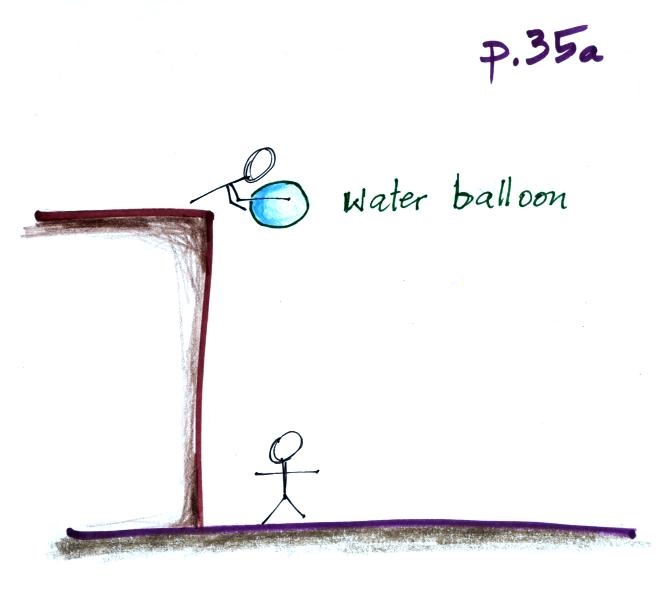
You probably shouldn't try this at home (or on campus). It's pretty obvious that if you fill a balloon with a little water and let go it will drop. And you probably know why (see below - I broken the figure on p. 35b into pieces for clarity).
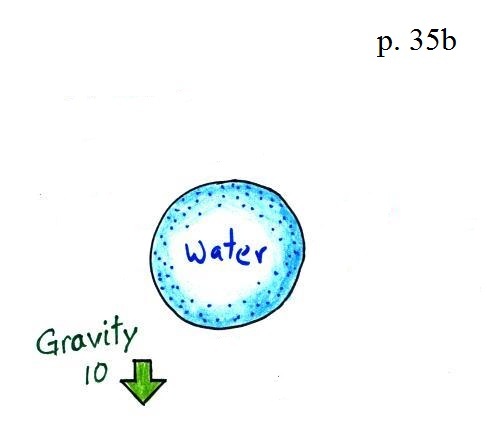
Gravity exerts a downward force on the balloon. I just made up a number, 10, to give you some idea of its strength. But the story doesn't end there.
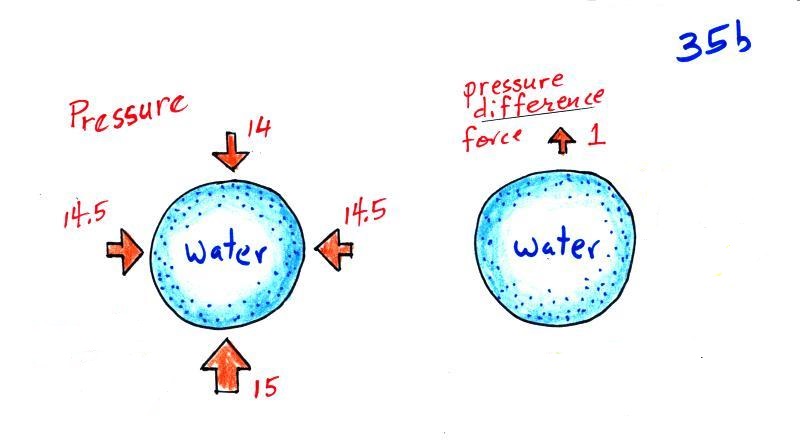
The water balloon is surrounded by air that is pushing upward, downward, and sideways on the balloon. These pressure forces are strong but mostly cancel each other out. The sideways forces do cancel out exactly.
The up and down forces aren't quite equal because pressure decreases with increasing altitude. The upward pointing force at the bottom is stronger (15) than the downward force at the top (14). They don't cancel and there is a weak upward pressure force (1).
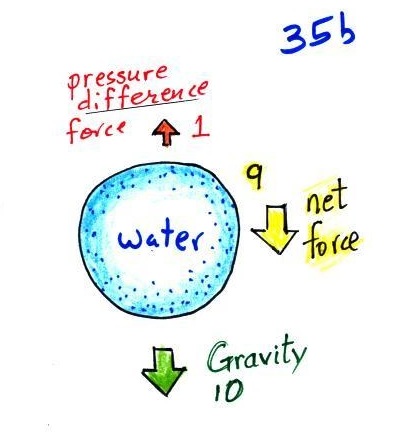
It seems like we could change things a little bit and somehow keep the upward and downward pressure forces from working against each other.
In the demonstration a wine glass is filled with water (about the same amount of water that you might put in a small water balloon).
A small plastic lid is used to cover the wine glass (you'll need to look hard to see the lid in the photo above). The wine glass is then turned upside and the water does not fall out. The water was colored red in the class demonstration.
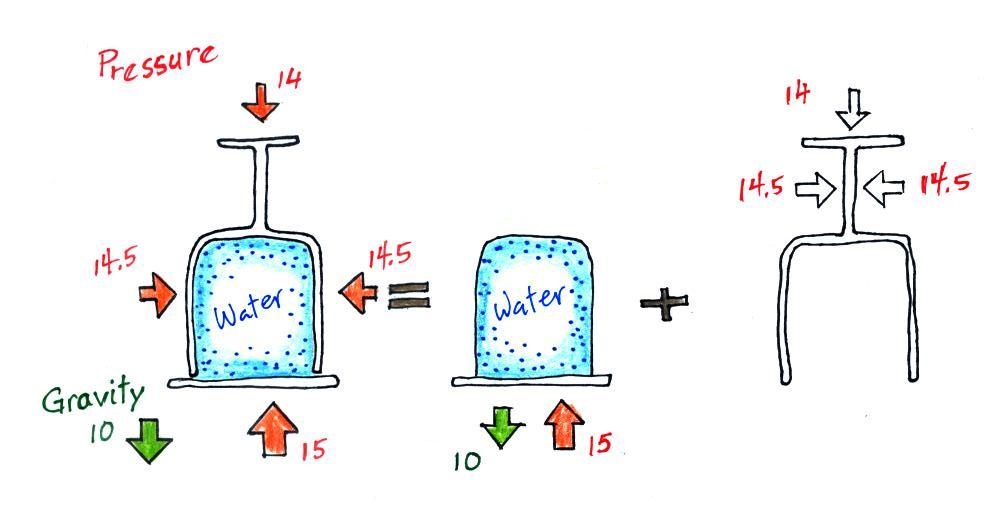
All the same forces
are shown again in the left most figure. We'll split
that into two parts - a water and lid part and an empty glass
part.
The 14 units of pressure force is pushing on the glass now and not the water. I was holding onto the glass, I'm the one that balanced out this downward pressure force.
Gravity still pulls downward on the water with the same 10 units of force. But with 15 units, the upward pressure force is able to overcome the downward pull of gravity. It can do this because all 15 units are used to overcome gravity and not to cancel out the downward pointing pressure force.
The 14 units of pressure force is pushing on the glass now and not the water. I was holding onto the glass, I'm the one that balanced out this downward pressure force.
Gravity still pulls downward on the water with the same 10 units of force. But with 15 units, the upward pressure force is able to overcome the downward pull of gravity. It can do this because all 15 units are used to overcome gravity and not to cancel out the downward pointing pressure force.
Air pressure pushes downward with hundreds
of pounds of force on someone lying on the beach.
The pressure of the air in tires pushes upward with enough force to keep a 1 ton automobile off the ground.
What about the sideways air pressure force?
Here's a description of the demonstration I'd like to try, it involves Magdeburg hemispheres and two teams of horses (the following quote and the figure below are from an article in Wikipedia):
" ... Magdeburg hemispheres are a pair of large copper hemispheres with mating rims, used to demonstrate the power of atmospheric pressure. When the rims were sealed with grease and the air was pumped out, the sphere contained a vacuum and could not be pulled apart by teams of horses. The Magdeburg hemispheres were designed by a German scientist and mayor of Magdeburg, Otto von Guericke in 1656 to demonstrate the air pump which he had invented, and the concept of atmospheric pressure."
The pressure of the air in tires pushes upward with enough force to keep a 1 ton automobile off the ground.
What about the sideways air pressure force?
Here's a description of the demonstration I'd like to try, it involves Magdeburg hemispheres and two teams of horses (the following quote and the figure below are from an article in Wikipedia):
" ... Magdeburg hemispheres are a pair of large copper hemispheres with mating rims, used to demonstrate the power of atmospheric pressure. When the rims were sealed with grease and the air was pumped out, the sphere contained a vacuum and could not be pulled apart by teams of horses. The Magdeburg hemispheres were designed by a German scientist and mayor of Magdeburg, Otto von Guericke in 1656 to demonstrate the air pump which he had invented, and the concept of atmospheric pressure."
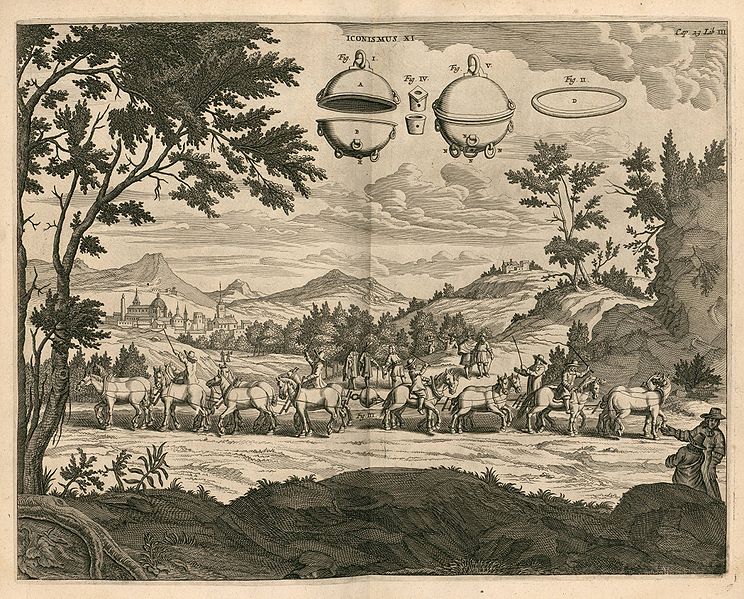
Gaspar Schott's sketch of Otto von Guericke's
Magdeburg hemispheres experiment (from the Wikipedia article
referenced above)
It is the pressure of the air pushing inward against the outside surfaces of the hemispheres that keeps them together. The hemispheres appear to have had pretty large surface area. There would be 15 pounds of force pressing against every square inch (at sea level) of the hemisphere which could easily have been several thousand pounds of total force.
I would like to see the demonstration staged in Arizona Stadium at halftime during a home football game.
Suction cups work the same way
The suction cup is the part on the left and has been pressed against smooth surface. The cup is flexible and can be pulled away from the wall leaving a small volume between the wall and the cup where there isn't any air (a vacuum). The surrounding air pushes against the suction cup and keeps it tightly pressed against the wall.
Air pressure outside the suction cup (caused by the collisions of air molecules) press the suction cup against a smooth surface. There no (or very little) air inside the suction cup and no pressure pushing outward. The suction cup is held against the surface (with a fair amount of force).
At this point it was time for the Practice Quiz. If you didn't take the quiz you can download it here. I would suggest you do that just to become familiar with the format.
You can download the answers to the questions on the Practice Quiz here.
We should have the Practice Quizzes graded in time to return in class next Tuesday.